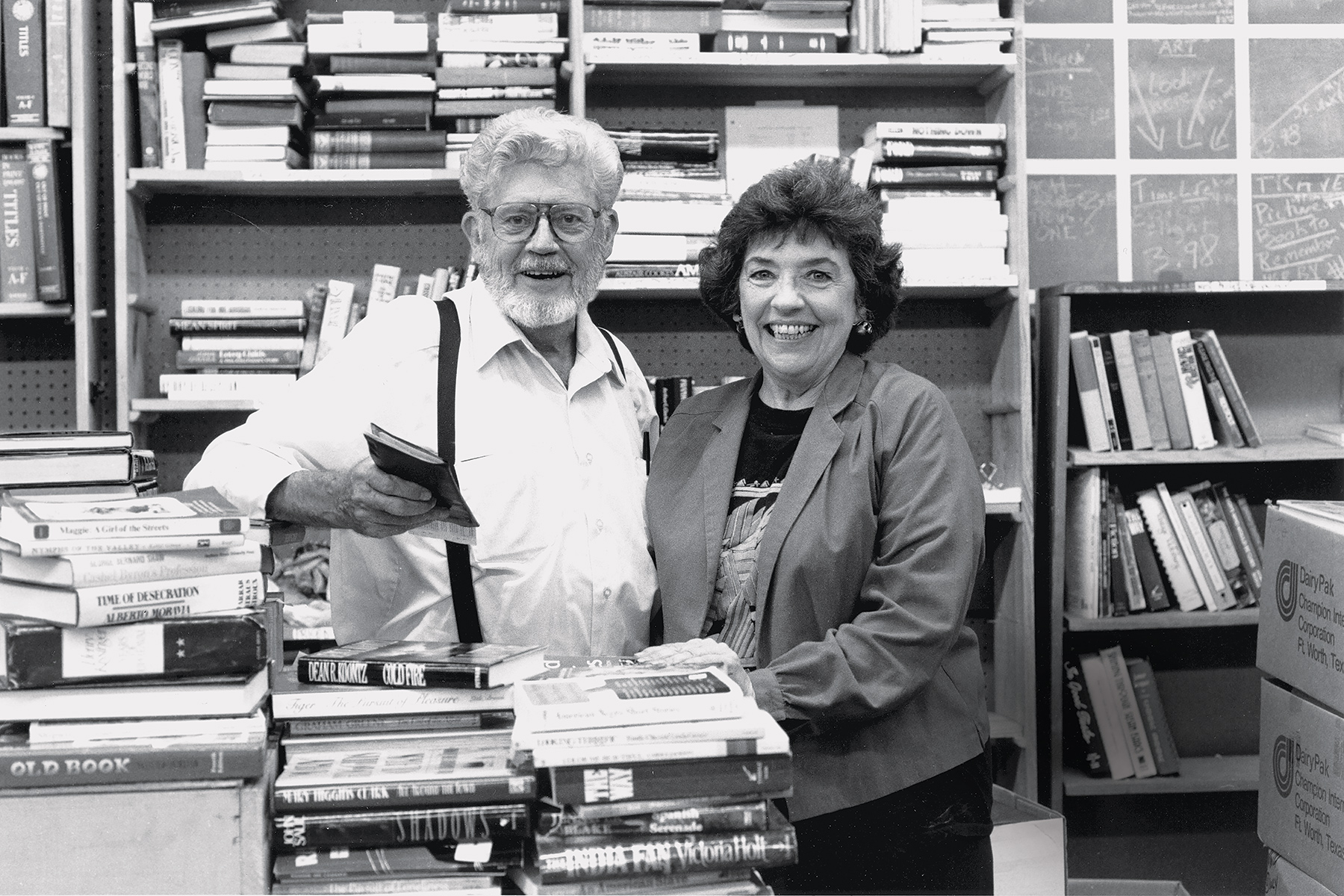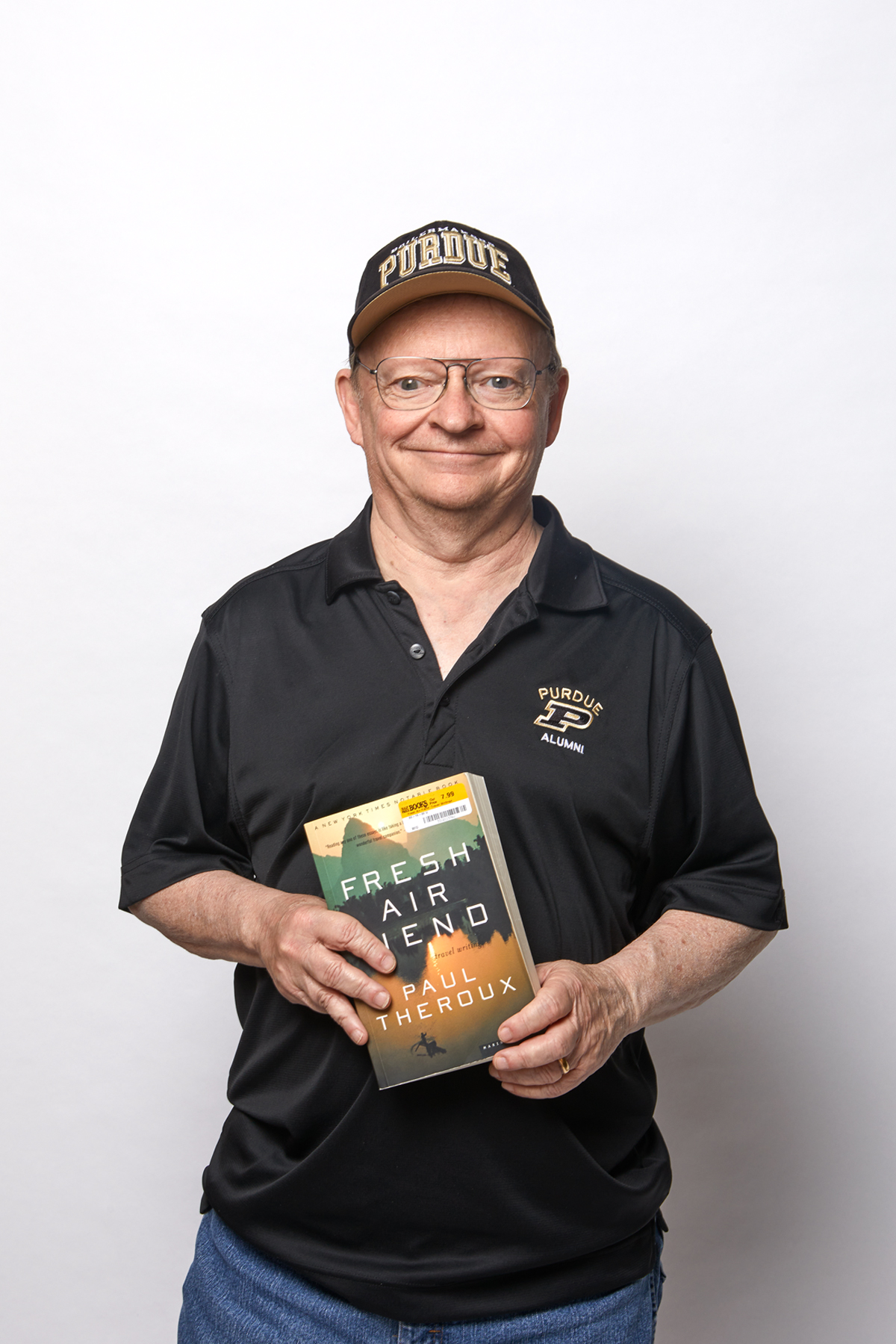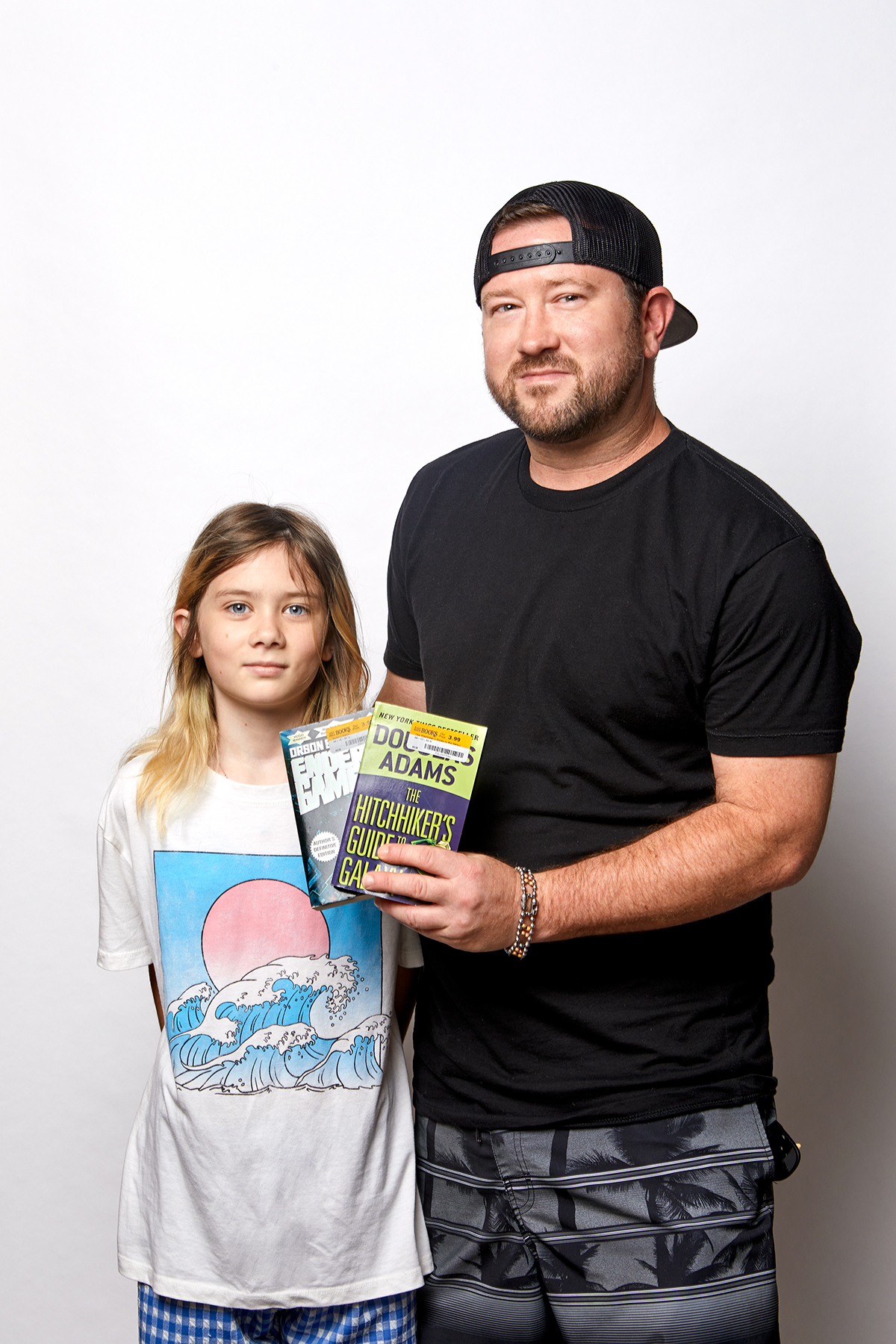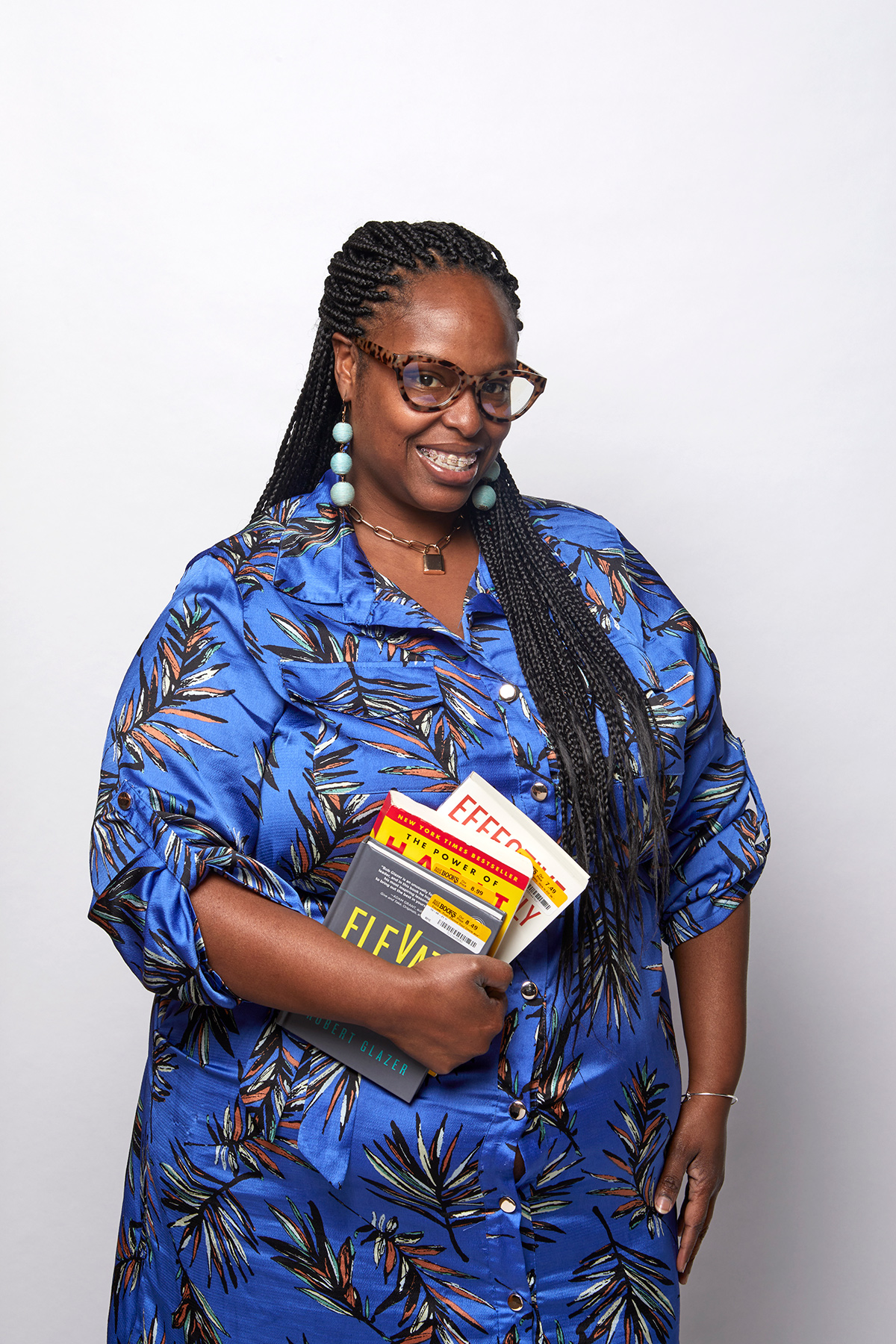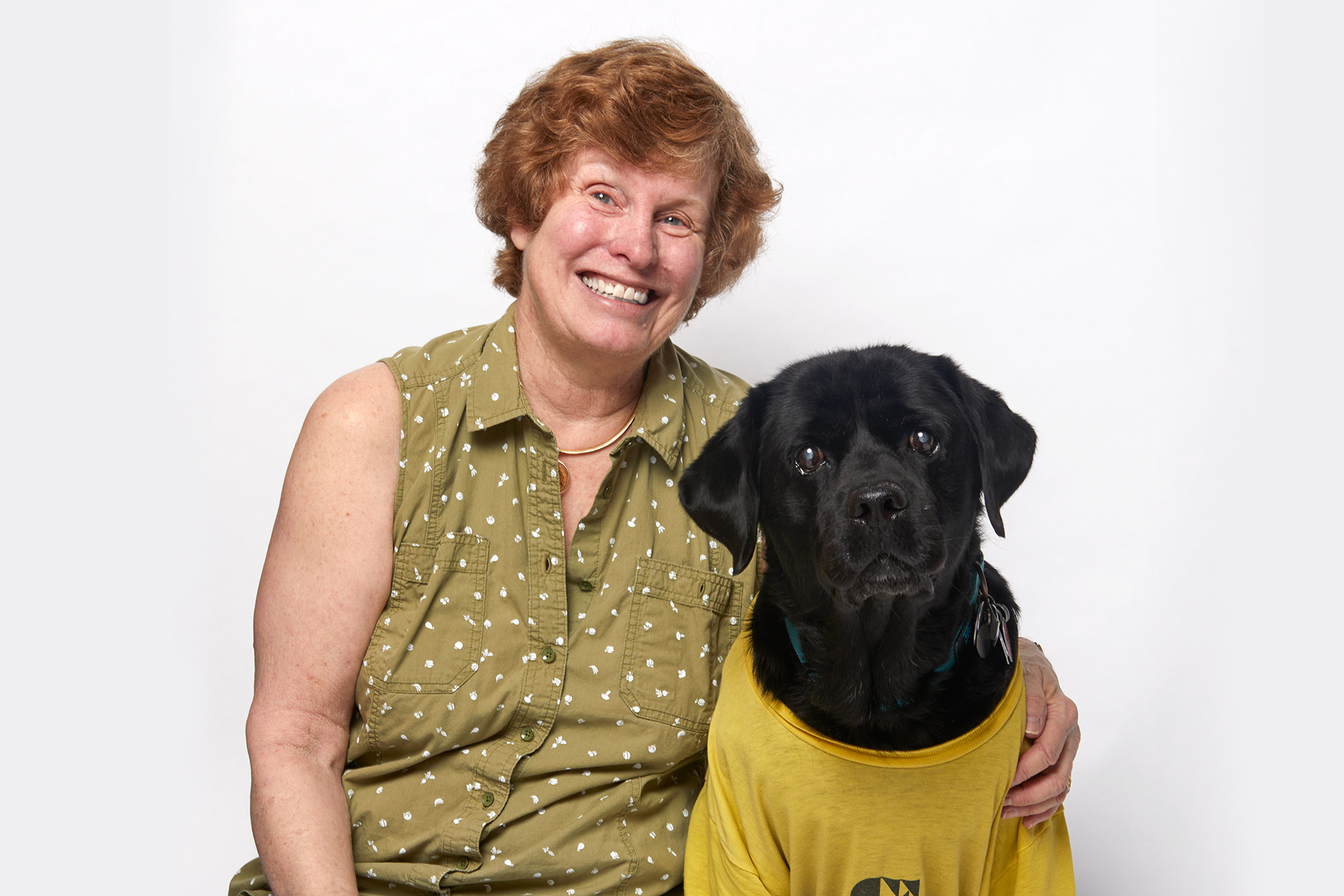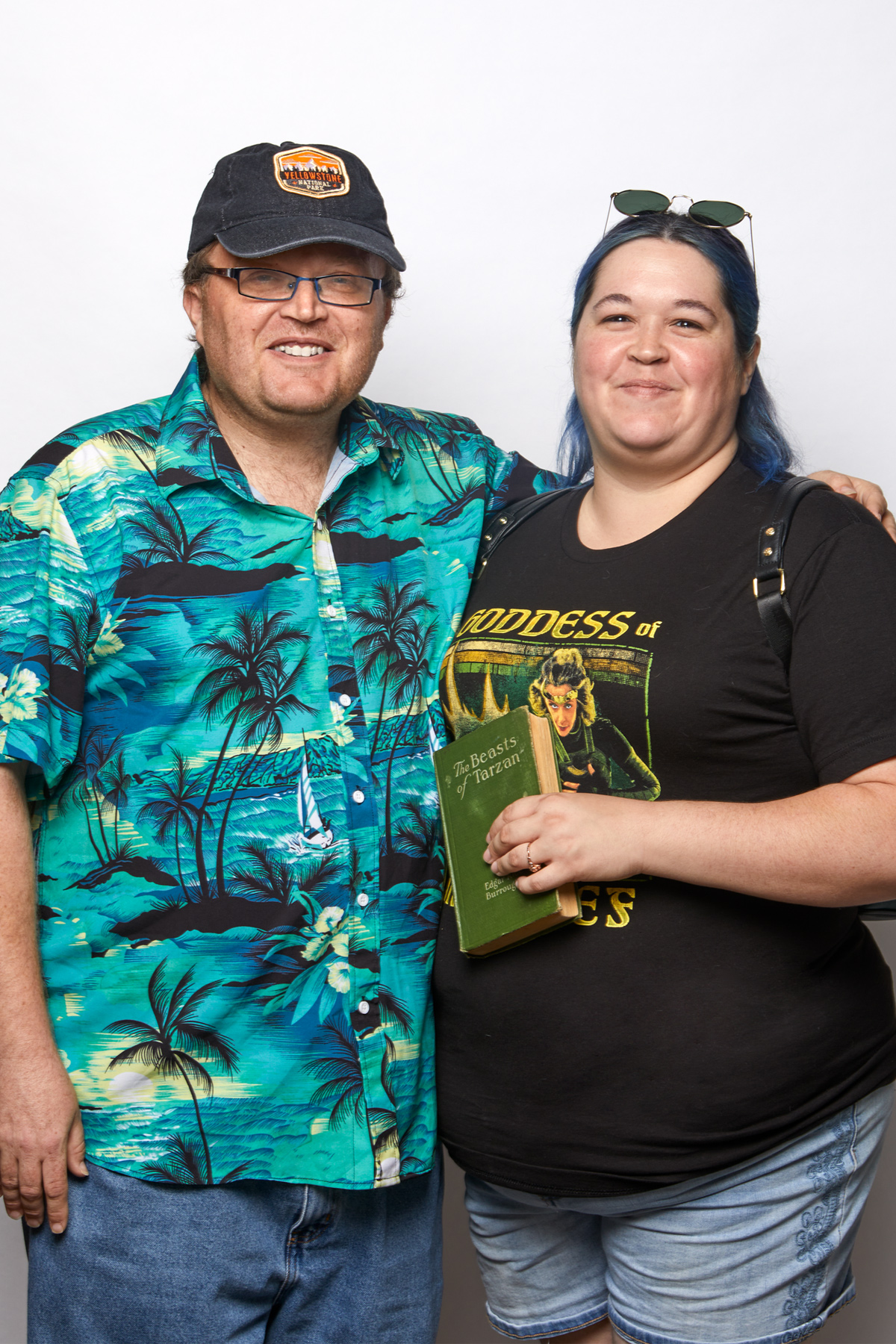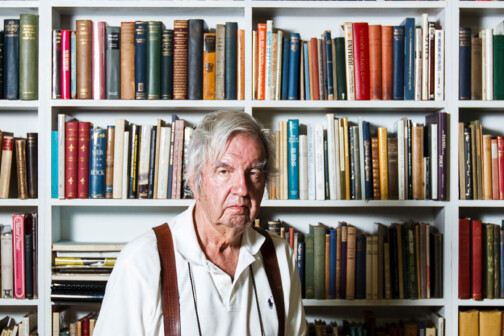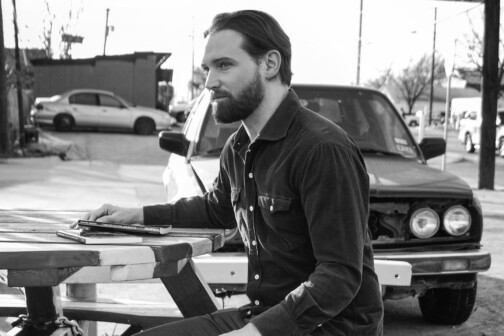Like Charlie Brown all grown up, Clint Landrum always wears shorts and a shirt untucked, and the crown of his head sprouts few hairs. Unlike Chuck, Clint is exceptionally personable. As he leads people from the Half Price information desk to the objects of their desire, Clint speaks as much with his entire body as he does with a soaring baritone football coaches would kill for.
“I think of Info as the literal and figurative center of the store,” Clint explains to me. “A lot comes through here—a lot.” I ask what kinds of things people usually look for. Clint takes in a long, deep breath, throws his hands up, and exhales, “It’s all over the place!”
The place is the Half Price Books flagship on Northwest Highway, a 54,000-square-foot store holding more than half a million new and used books and other media, including more than 50,000 LPs and CDs and everything from resale Fitbits to Magic: The Gathering cards. Among the stacks are such subsections as Conspiracies & Assassinations, Paranormal Romance, and one shelf labeled Knot Tying. After a few hours tailing Clint, his claim proves true.
A gentleman with liver spots looks for Michael Koryta. A young woman with black hair and bleached eyebrows is after James Baldwin. A metalhead with a ponytail falling like a dead snake down his back requests the key to a display. The boxed action figure will be No. 24 in his Harley Quinn collection. An exasperated grandpa asks how in the world a Dr. Seuss book could cost $50 (it’s out of print). One person can’t find the calendars, another, the discount Christmas cards (both sold out). A woman wearing a loose black suit and woven flip-flops seeks the Christian section. A translator for a Catholic organization, she asked the Holy Spirit to guide her to a “novel kind of thing.” Her eyes fix on spines that read “St. Teresa.” Prayers answered.
A Minnesotan searching for Titanic material is confused by a section Clint suggests they check. “Ya know, it wasn’t really a Natural Disaster,” she points out. Clint tells me they get a lot of out-of-towners. Moments later, a Northern Californian with a gray shag and tie-dye t-shirt appears. She had just sent a video to friends proving her arrival at “the mothership.” On other occasions wandering the Half Price aisles, I run into an Arizonan in Cooking rummaging for a favorite 1970s Betty Crocker. “She doesn’t even know the name of it,” her companion says.
“Well, it just said ‘cookbook’ on the side!” says the Arizonan.
There was also a smartly dressed woman from Washington state plucking through sheet music. A couple of dudes from Louisiana in town for a show at the Granada. I heard a woman and two teenage girls have a vigorous discussion in Italian over the contents of their shopping basket. The Venetian trio carried travel-size games and a gold-leaf collection of Laura Ingalls Wilder.
A foursome of young men walks to the counter. One with Down syndrome and short, unkempt dreadlocks struggles to get words out. An aide wearing Oxford shoes steps up, looks to the rafters, and feeds the young man lines.
“Do,” says the aide.
“Do,” repeats Dreadlocks.
“You.”
“You.”
“Have.”
“Have.”
“CDs?”
“CDs?”
An hour after the group is led to the compact discs, Dreadlocks finds Clint and wraps him in a bear hug. People often look Clint in the eye and shake his hand after he drops them at their destination, “especially the men,” he says.
Across from the info desk, I notice an interesting tableau: three men sitting cross-legged, one next to the other, thumbing through comic books. Nearby, a woman scrolls TikTok as she waits for her boyfriend. I approach a man standing on the opposite side of the comic book crates. He is wearing camouflage pants and sporting a buzz cut and delicate eyeglasses. Sheriff Osni says he started collecting Superman comics as a child in France. At 24, he immigrated to the United States and was promptly recruited by the military when he registered with the selective service. “Would you like to be like Rambo, a lean, mean killing machine? Sign me up,” Sheriff says. He spent 17 years overseas. When he returned, his family had given away his entire comic book collection. The combat veteran now teaches business classes and culinary arts at the Art Institute of Dallas, and he visits Half Price two or three times a week to sift through the comics. A room in his home holds issues by the hundreds. “I call it my Fortress of Solitude,” Sheriff says.
By late afternoon the store is hopping, phones ringing, and all the sounds come together as a white noise of marketplace activity, a welcome din to Clint. He worked many lifeless days during the pandemic. “It’s like a church,” Clint says, arms waving. “A church is a building. People make it a church. And what converts this from a big box are the people.”
The CEO of Half Price Books is named Sharon Anderson Wright, but everyone from booksellers to board members knows her as Boots. “I’m named after Gary Busey’s dog,” she tells me as we tour the corporate offices stationed on the flagship store’s second floor. For a moment, I’m left to do the calculus on whether she is speaking of the Hollywood eccentric and whether anyone in the 1960s could be such fanatics. Not fans but neighbors, it turns out, with a beloved pet named Honey. “Evidently Honey and I would run around together, and I declared that my name was also ‘Honey Boosie.’ I couldn’t say it right. Then it became Bootsy and then Boots.”
Vermont, among the Bens and Jerrys, seems a more probable place to find a jeans-wearing, salt-and-pepper-hair-flowing corporate figurehead such as Boots. She lives on a half-acre in Richardson, cultivates milkweed on a Sachse pasture to support monarch migration, and now spends most of her time at Rooster Home & Hardware, a quaint East Dallas shop she saved from extinction. Boots also may not be the likeliest of people to helm the nation’s largest, family-owned, new and used bookstore chain. For one, reading has never come easy; she has long suspected she’s dyslexic. She took a few community college classes but never earned a degree. For 26 years, she has run the company off intuition and instinct and within the vision of its founders. Earlier this year, Kathy Doyle Thomas was elected to take on the role of president. Boots and Kathy joke that she’s something of a Half Price newb—Kathy has only been with the company for 33 years. Boots has been around for all 50.
The Half Price story goes back to 1972. That’s the year Jane Fonda climbed onto a North Vietnamese anti-aircraft gun, the year police apprehended Nixon’s henchmen in the Democratic National Committee headquarters, and the year Ken Gjemre, a 51-year-old University Park father of six, turned his life upside down—or right-side up, depending on your worldview.
Ken marched through Europe as a forward observer during World War II. FOs were the eyes and ears of the artillery unit and usually came home in a casket. Ken returned with a Silver Star for battle gallantry. He had nothing good to say about the experience. After serving stateside in the Korean War, he became a staunch pacifist. And so, in 1972 as the presidential primaries geared up, Ken took a four-month “political leave” from his executive role at Zales Corporation, determined to launch a third political party. The effort failed, as did his marriage and his desire to “sell people things they didn’t need at prices they couldn’t afford.”
“Corporate dropout” is the badge he wore proudly in the many news stories to come, where he would also declare himself an environmentalist, a Gray Panther, a militant feminist, a civil libertarian, and a member of the Unitarian Universalist Church. Those who knew him refer to him as “larger than life,” “a frustrated dreamer,” and “loquacious.” He once charged into a live news broadcast to protest a stolen election (he jumped the gun; his candidate won). He served as the executive vice president of the ACLU’s Dallas chapter, helped launch the Dry Gulch recycling center, and, in 1978, sued Dallas ISD for requiring prospective superintendents to be openly Christian. Ken ran for various offices over the years, including the state senate, but lost every time. It probably didn’t help that he refused all PAC money. (“Let’s face it. It amounts to bribery,” he argued in a 1986 D Magazine profile.)
‘Corporate dropout’ is the badge he wore proudly in the many news stories to come, where he would also declare himself an environmentalist, a Gray Panther, a militant feminist, and a civil libertarian.
Books seemed an acceptable trade for an idealist. Yet, divorce proceedings froze his assets, so he borrowed $4,000 from a whip-smart brunette more than a decade his junior named Pat Anderson—Boots’ mother. Pat, a housewife, started studying psychology at UNT in the late ’60s. Boots remembers her mom returning from Denton, carrying peace signs and protest placards and wearing black armbands. An avid reader, Pat tore through a mystery each night. Her husband sold cuckoo clocks and Towle silver to Ken at Zales, and the families became friends. “And one thing led to another,” Boots says. (“It was the ’70s” is a refrain I hear again and again.)
Ken signed a lease for a boarded-up laundromat at Lovers Lane and Inwood Road, the site of “assaults and an occasional murder,” according to a 1981 Dallas Morning News story. The upshot: cheap rent, only $175 a month. Pat saved money by buying mixed paint; all the walls ended up different colors. They acquired the contents of a bookstore going out of business, foraged from garage sales, and pooled their own extensive libraries. Boots and her sister Ellen, 13 and 17 respectively, were instructed to judge books by their covers: Westerns had cowboys, Gothic romances had women running from houses, historical books were thicker.
A minister friend couldn’t get rid of 300 records at a moving sale, so Ken picked them up. It only took a weekend to clear all but six. By 1977, Half Price had seven stores. By 1981, they reported revenues north of $5 million with 16 locations. There was no strategy to their expansion in the early years. A staffer would move back home to Seattle and set up shop. Same with Minnesota and Wisconsin. Waco was a good place for a bathroom break on the way to the San Antonio store. Today there are 123 stores in 19 states. (Half Price declined to share their latest revenue numbers.)
For years, Pat and Ken resisted all semblances of corporate trappings and made few rules: no more than one staff dog per store; no tank tops (even that stricture ruffled bookseller feathers). Categorizing the stock was all they were willing to do; no effort was made to alphabetize because book lovers “like to grub around a bit.” It was a philosophy that stuck for decades, for better or worse. Half Price didn’t digitize its catalog until 2011.
“I think I’m credited, or there might be another word for it—blamed—for introducing the first desk to Half Price,” Tim Jernigan says. Now retired, the one-time radio news anchor joined as a bookseller in 1975 and took on HR duties as the chain grew. “When I started, the corporate office was at their house, 4811 Swiss Avenue, and the filing system was those steps leading to the garage apartment, different stacks of paper on different steps.”
Vice president of operations Jan Cornelius says, “It was like a head shop that sold books instead of roach clips.” Jan was hired as a bookseller in 1981, and it took him some months to find his groove at Half Price. It was a sleepy business and he was an “aggressive shelver” after the harrowing experience of working as a page in the Dallas Public Library’s genealogy department when Roots debuted.
“It was a swirling stew of ideas,” Jan says. “We had a lot of time to think about things and talk about things. Overeducated, undercompensated people tend to do that. They talk a lot. And they think a lot. And that’s what we did. And as luck would have it, some of the ideas turned out to be pretty damn good.”
One of the ideas was buying books that publishers couldn’t get rid of. Ken approached publishing reps at book conventions who couldn’t imagine they might be left with overstock. Not one to walk away from a deal, Ken insisted they call their warehouse managers to double-check. Today, 30 percent of Half Price inventory is comprised of new books, called “remainders” in the industry.
If there was any rigid structure to the Half Price enterprise, it was Pat and Ken’s belief system. They instituted a profit-sharing program, splitting a percentage of company-wide gains equally among all employees each quarter. Since Ken changed his life in his 50s, employees are granted retirement at 55 should they choose to take it. The company was an early adopter of domestic partner benefits and paid paternity leave. They offer family leave to care for sick pets. “Some people don’t have spouses or children, and pets are their family,” Boots explains. (Corporate is currently in talks with booksellers across Minnesota, Illinois, and Indiana, who recently unionized.) The company has donated and recycled millions of books over the decades, giving 11 million to schools and nonprofits in the last 10 years alone.


In addition to profits, love blossomed amid the stacks, and a stable of Half Price babies sprang up. It wasn’t unusual to see booksellers’ kids running up and down aisles. Ellen O’Neal, Boots’ sister, who opened the San Antonio store, recalls interviewing and hiring a male employee while breastfeeding. It was Ellen’s son, however, who forced Half Price to institute regulations on ambulatory offspring after he climbed a paperback rack and toppled the watercooler, swiped staffers’ food from the fridge, and broke a photocopier by stuffing it with a teddy bear. Now 40, Brady O’Neal works as the company’s risk manager.
Offices and desks were inevitable. Today’s corporate quarters look much like the store, cement floors and offices framed in pine. Boots keeps her mom’s desk in a hallway as something of a shrine. There’s a photo of Pat’s workspace, a chaotic scene that could only be rivaled by Francis Bacon’s art studio; an accounting ledger marked with her tiny, neat handwriting; a container full of pencils worn to 2-inch stubs with erasers fully intact, a point of pride because Pat “didn’t make mistakes.” Boots points out a framed handwritten copy of “Mama’s Philosophy” that includes such tenets as, “Don’t fight with people you can lick. (In your case and mine that’s damn near everybody.) It makes you feel bad later.”
While Ken enjoyed the spotlight, Pat ran the show backstage. She was a straight shooter with no patience for meetings, known to abruptly walk out when she didn’t like what she was hearing. But Boots insists her mom was loving and kind. “After she passed, we found out she’d given the janitor $20,000. He brought it back eventually, and says, ‘Pat loaned this to me when I was down and out,’ ” Boots says. “She’d help anybody, but, you know, she didn’t tolerate fools.”
Ken referred to Pat as “my most significant other who doubles as my business partner,” but the pair never married. “Every Tuesday they decided they were gonna stay together for the week,” Boots says with a shrug. (In 1985, Boots drove a drummer-slash-Half Price staffer named Ken Wright to the hospital after he broke his leg jumping a wall in the store parking lot. They’ve been together ever since.) In their later years, Pat and Ken were more off than on, though it was Pat who jumped on a plane to care for Ken when he suffered a stroke in Germany in 1991. Saddled by smoking-induced pulmonary disease, Pat died four years later at the age of 63. Boots took over operations and Ken sold his shares back to the company when he retired to Ojai, California, near family. He died in 2002 and donated his body to the UCLA medical school.
Boots has spent her entire adult life, and then some, under a Half Price roof. At 17, she and her dog Dylan had the run of the Richardson store. She sold books to Mick Jagger and Michael Jackson at the former Mockingbird location. (Jackson asked for photography books with children and anything relating to Peter Pan. After he left, she managed to rustle up a 1930s illustrated Peter Pan, priced it accordingly, and phoned the Anatole.) She became CEO when the Half Price flagship was housed in the old Captain’s Cargo store next door that had a giant galleon ship in the heart of it. The current Northwest Highway flagship is Boots’ mark on the company. It was a risky move, buying the 12 acres that stretch to include the developments across Shady Brook Lane and a parking lot near Henk’s European Deli and stocking such a large retail space. She wasn’t sure if they’d be able to fill it all up before opening in 1999.
As Boots walks me through the corporate offices, she pulls a framed photo from behind some paraphernalia on a paper-cutting station and shows me a crowd of smiling faces gathered at a staffer’s going-away party, her and Pat among them. “That’s the last time I saw my mom alive,” Boots says.
“Oh, I don’t know why that’s there,” says a staffer behind us. “It used to be up on the wall.”
“Cuz I got tired of looking at it,” Boots says, and returns the memory to its ad hoc crypt.
The most expensive item at the Half Price Books flagship is a $20,000 first edition of Charles Darwin’s On the Origin of Species. Otherwise, “Half Price Books” is no misnomer. Most of the bookshelf merch is tagged at half the book’s original list price, making it one of the only bookstores to necessitate shopping carts.
There’s nothing precious about the Half Price environment. The concrete floor is chipped and roughed up, marked with spots of spray paint or an errant sticker. Stains dot the low-pile carpet beneath bookshelves made in the company’s own woodshop from No. 2 common pine. Other fixtures are made of plywood and repurposed materials from the Sterling Jewelry store that once occupied the building. Tables and chairs were picked up at the Canton flea market.
What keeps it from feeling like a dank warehouse, though, are skylights and expansive windows lined with potted plants. Even some of the plants are remainders. The man who maintains the oversize Dracaena and philodendron will bring rejects from other corporate clients and nurse the ailing plants back to health in the Half Price light.
As for the decor, those funky paper sculptures sitting atop fixtures—the colorful peacock in Rare Books and Grim Reaper in Fiction—they were made from books headed to recycling by Kiki Baughman, the store’s display specialist, who used to design packaging for Frito-Lay and Dr Pepper and now keeps a lone workspace among the storage boxes in the cavernous Half Price basement. Kiki makes many of these curiosities to correspond with author signings. Case in point: a helicopter with battery-powered blades for an event with thriller novelist Brad Thor. A 3.5-foot-long tiger carted to Earth Day and other events took 80 hours of hand-cutting, pasting, and airbrushing. “I have to admit, it’s a pretty juicy job,” she tells me. (She also takes outside commissions and recently made a woven-bodice wedding dress made from Neil Gaiman book pages for a bride getting married in a library.)
Kiki is in charge of booking the frequent signings as well as other community events. Pre-pandemic, you’d walk in the store to see more than 100 people playing board games spilling out of the community room or a live DJ spinning or a craft night in which tote bags were fashioned out of LPs or a kids’ storytime or a couple dozen musicians strumming guitars. The Acoustic Jam was not an authorized Half Price event, nor were the quilting or poetry groups that met at the store.
One Sunday, I saw that seven young adults had commandeered the playhouse in the children’s area. They were huddled around a small table, knees in their chests, as they colored coloring book pages and discussed the PowerPoint slides of their Bible study. Unless someone is disturbing the peace, panhandling, or shoplifting, the staff attitude is strictly laissez-faire. You can even sit down with two tall stacks of CDs, open the jewel cases one-by-one, and read every page of the liner notes like a novel. I’m not sure why you would do this, but I have seen it happen.
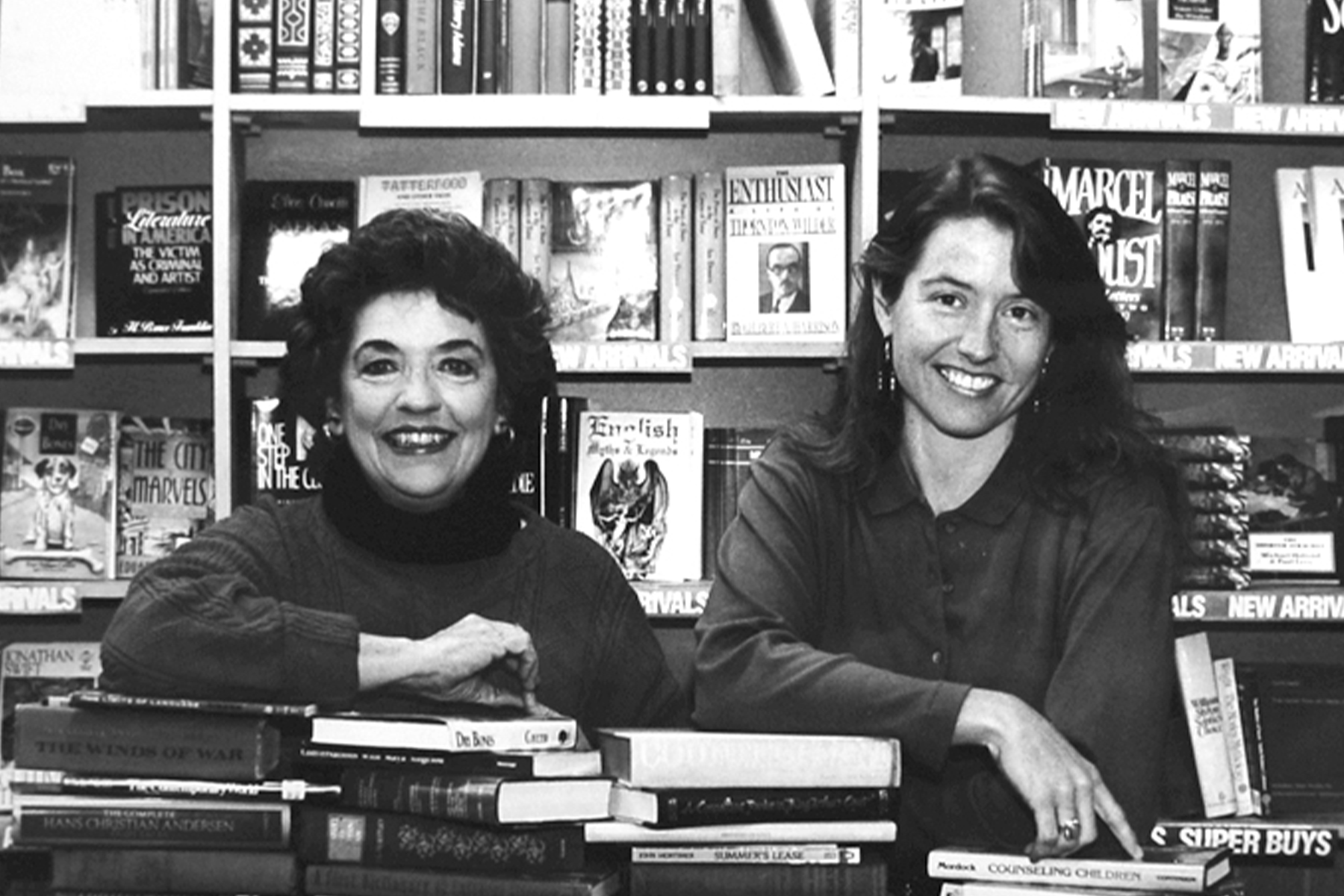
The easygoing nature inspires a sense of refuge. I watched, one Saturday morning, as a white-haired man, slightly hunched in a polo shirt and braided belt, approached a man reading a book in the store’s west wing.
“You must like that Lee Child,” the old man said.
“Yes, sir,” the man said shyly. He was thirtysomething, hair in need of a trim, wearing cutoff sweatpants over longer sweatpants.
“I’ve seen you in here before with those books,” the old man said. “I’ve read every single one of ’em. Love ’em.”
The younger man left before I could talk to him, but I started checking the shelves of Lee Child’s Jack Reacher series. The man marked his place with a folded map of the store. Never Go Back, p.247. The next day, p.256. Several days later, Nothing to Lose, p.336. I finally bumped into him weeks later near the Business section.
The man said he’s been walking from his apartment in Vickery Meadow to Half Price almost daily since losing his construction job several months back. In that time, he’s read eight or nine of the Jack Reacher novels, a couple by Michael Connelly and Tom Clancy, and also The Hunger Games trilogy. People leave him be, except every now and then, when someone asks for a critique of the novel in his hands.
“Has anyone ever bought the copy with your book marker?” I ask.
“Oh yeah, that’s happened to me a couple times,” he says, his face lighting into a grin showing a jagged front tooth. “I couldn’t find my place so I had to start all over. I was like, Aaaaghhh!”
Silverfish could wreck a place like Half Price Books. The metallic hexapods make a bacchanal of cellulose-rich paper and bookbinding glue. If staffers at the Buy Counter find more than one of the pests in any given box, they’ll swiftly pack it up and slide it back to the customer. Same goes for more than a few rat or roach droppings. Manuscripts reeking of cat urine go straight in the trash bin. Half Price no longer accepts smut. (Ken Gjemre called porn “a degradation of the human spirit.” But in his mind, censorship was a sin far worse.) Otherwise, the store, as advertised, will “buy anything printed or recorded except yesterday’s newspaper.”
The Buy Counter has regulars, including Michael Johnson, who takes great pride in the contents of his banana boxes. He gathers the loads from garage and estate sales across Texas and then hauls the cream of the crop up from his home in Ennis each week. “I don’t bring them crap,” he says.
Wearing a Rams cap and crisp white jeans, Johnson gets around well for an octogenarian. He discovered Half Price in its infancy, when he made deliveries to the grocers across from the laundromat location. “I was into comics real heavy at the time,” he says. At one point, Ken and Pat even came to his house to negotiate the procurement of an Iron Man book.
As the Half Price staffers evaluate his weekly cache, Johnson strolls the aisles looking for volumes to round out his home library. He calls himself a “completist,” meaning he tries to collect every book written by particular authors. “Sometimes it can be an expensive situation,” he says. “What I get when I sell largely determines what I buy because I’m on a budget. And I never ever go off of it.”
On this particular day, the plastic shopping bag bound for home includes William F. Buckley Jr.’s High Jinx, Larry McMurtry’s All My Friends Are Going to Be Strangers, Donald E. Westlake’s Trust Me on This, Richard Wheeler’s Witness to Gettysburg, and an old collection of sci-fi stories (not usually his kind of thing, but it was only a couple bucks). “I could talk about books all day long, much to my wife’s discomfort,” he says. “She reads Biblical stuff.” Also inside the bag, a mauve journal in which he keeps a handwritten list—scrawled in and scratched out—of all that he collects and divests, the register of his life’s work.
For at least one man, selling books to Half Price is, in fact, a livelihood. Eron Diggles brings two carts’ worth of books to the Buy Counter most days. “They limit me,” says Diggles, his eyes hidden behind D&G aviators, cobalt sweatpants and velvet loafers down below. “I’ve probably filled up all the shelves in this store four or five times.” Staffers assume he buys abandoned storage units, but his explanation is somewhat fuzzy. His dad pulled him into the used book trade 15 years ago, he says, and he has built a reputation.
“I got a business where people that know me, they basically buy things and they give me their books.” Diggles rubs his thumb along the line of his meticulously groomed beard and lowers his voice. “I’m actually on the verge of opening my own store.”
Half price books is a fifty-year social experiment. By design, the store you visit Sunday won’t be the same Monday. It’s a living organism in a continuous state of evolution. One man purges, another consumes, each Half Price location a creation of its own unique community.
I met a pair of beaming sisters who came for romances and left with an old directory for their father’s historically Black fraternity. I witnessed the moment a boy wearing SpongeBob shoes and a SpongeBob t-shirt happened upon a SpongeBob board game; my ears still ring with the squeal. Why would anyone want a tattered copy of Shrimply Delicious, copyright 1967, containing such recipes as “Shrimp and Anchovy Tomato Cups” and “Three-In-One Ring Mold”? Or a 2-inch-thick book of ephemeris tables for the years 1931 to 1980? Who are you or I to say?
I do know that some day, someone will ask for the key to the case containing the Mary-Kate and Ashley Olsen Nintendo Game Boy cartridge, and for a moment they will feel joy and validation within this place that we increasingly think of as fading—a physical point of convergence between strangers with completely disparate interests.
Of course, some things are universal.
“Has anybody mentioned our bestselling book for years and years?” Charles Dee Mitchell asks. Dee, as he is known, fell into the Half Price fold in 1973 after the opportunity to pen the script for a friend’s low-budget horror flick didn’t pan out. For a while, he and a dog named Ballpark ran the old laundromat location, but Dee soon took over the purchasing of new books until 2006, when he retired, cashed in Half Price shares once worth a dollar, and became an active arts patron and curator in Dallas.
Dee says there was one particular book he discovered that flew off Half Price shelves. He originally ordered 500, then 1,000, then eventually something like 10,000 at a time. When the British publisher informed him that the book would be discontinued, Dee asked for the U.S. exclusive. As of press time, the company has sold 301,000 copies since 2001. It’s a 5.9-by-4.7-inch paperback, always at the register, priced at $3.99 that “everybody’s always buying for somebody else,” Dee says.
The miniature tome’s title: The History of Farting.
Meet the Readers
Drake McWhorter, 28
Comic book YouTuber
Have you come here before? All the time. I used to live down the street, and, actually, I’m here today because I reserved a book that I was trying to find all through the D-FW Metroplex; they only have one copy. What do you do? I do YouTube. I cover comic history. How many subscribers? About 400,000. I’ve been in YouTube professionally since 2011. Comics is now my bread and butter. I fell in love with the medium from a girl I dated in 2014. Living right next door, I was able to buy like four books a week, and I was tearing through those. Now I’ve read thousands of issues. I’ve become one of the world’s leading authorities on comic history.
Felecia Hardeman, 66
Retired teacher and High School Counselor
How did you find this store? I worked up there on 75 and just started to come down here. Where did you work? I was a counselor at Northwest High School. DISD. I’m retired. That sounds like a hard job. I liked the kids, so it wasn’t hard for me. But it was difficult for some people around me because the children today. I’m not bragging, but I had the sensitivity, or the wherewithal, to deal with them.
Glenn Weissinger, 67
Retired Vice President of Strategic Planning for Lockheed Martin Aeronautics
How long have you been a Half Price customer? It was ’78, when I moved to the area. One of the first things I did was hit the Yellow Pages for bookstores because I collect books. What kinds of things do you collect? Yes. [long pause] Oh, ha! You know, nonfiction, fiction mostly, science fiction, fantasy, mystery, historical fiction. A bit of everything. How many books do you have? Last count was about 10,000. They’re all alphabetically done except for the nonfiction, which is Dewey Decimal System.
Yanella Carpenter, 76
Retired Paralegal
What’s the most you’ve gotten from selling books? A couple of hundred dollars. I had three grandchildren and, you know, two families buying for all those kids. And the books were repeated, so some of them were brand new. What’s your accent? I’m from Mexico City, but I’ve been here forever and ever. I got married. It was easy. There was not this fight and hatred about immigration and all that. Is your husband with you today? Oh, no. I’m a widow. Twice. I decided after my second one, this is enough. I don’t want any more. I don’t know how to deal with that pain.
Supannee “Noi” Phoochada, 39 + Cooper, 3
Stay-at-Home Mom + Kid
What does your son like? Noi: Every contraction book and train and car. He likes stuff like that. Where are you from? Noi: My husband worked in Thailand for five years; that’s where we met and married, and then he got a new job here. He works in finance. How do you like Dallas? Noi: It’s warmer than other states. Cooper: Mommy. Mommy, can you read? Noi: But Dallas, its many Asian people and Asian restaurants and—Cooper: Mommy. Mommy. Mommy. Mommy, here read this. Noi: You want me to read for you? Yeah, I will.
Tom and Jill Taylor, 77; 71
Retired Math teacher; Retired Math and Computer Science Teacher
What are you doing here today? My wife came for a book, and I followed her in. How else are you spending retirement? I got to be a poll worker last Saturday. We need more poll workers; we were short. What else is keeping you busy? Tai chi, cuz it’s movement. I used to do yoga. I don’t do that anymore. I prefer the tai chi. You got Lincoln Highway? My book club is reading it. I have my name on the library list and I’m like 140 and there’s only 40 copies, so something told me I might not get it.
Jon Ackert and Piper, 44; 10
Bartender; Online School Student
What brought you in? Jon: I’ve been reading Harry Potter to her every single night that I have her. It’s been like three years since we started, and we just finished it last week. So we’re in here trying to pick a replacement, or at least pick up something until we find the next series that we like. What did you think about Harry Potter? Piper: The most amazing series in the world, and the movies are not as good—at all. What did you buy today? Jon: The Hitchhiker’s Guide to the Galaxy, and we also got Ender’s Game. It’s a sci-fi classic. But again, it’s about a kid. I was surprised we didn’t find it in the young adult area.
Victoria Lee, Daniela Martinez, Hannah Dryden; 18
Seniors at Lebanon Trail High School in Frisco
Why did you all come in today? Hannah: I found out about this place a year ago, and it’s like, finally, we decided to come. This is senior skip day. We’re all kind of bookworms. Is this the wedding section? Daniela: It’s so cute to look at. There’s so many different types of ideas for, like, the perfect wedding. Do you have a boyfriend? Daniela: [shakes head] That’s why I love coming to this section cuz I like to come in and, like… Hannah: Dream.
Ava Moss, 38
Project Manager for RealPage
What are you shopping for? Some marketing books. I’m currently in tech, but project management, and I want to transition into product marketing, and I was referred a couple of books. So you have a specific goal? I have a list. But I do come here when I feel a lot of anxiety. When I feel overwhelmed with life, sometimes I just wander around and read books, put them back. I think it’s just a way for me to escape in a quiet place and not be tempted to spend a lot of money. And then if I feel like I want to buy myself something, I get a journal or a bookmark, or something like that. But mostly I get to explore different things and take my mind away from what’s going on.
Luna Clark, 12; Beth + David (not pictured) Clark, 70
Retired Field Trial Competitor; Dog Owners
What’s with the t-shirt? Beth: She has diabetes, so she’s got a sensor on. David: She came from a friend of ours who does field trial dogs. It’s not normal in her line, just bad luck. Field trial? David: They’ll shoot a decoy out across a lake. And the dog goes down to the water, swims straight across, goes across a point of land and then back. She was one of the top dogs, but because of the diabetes, the breeder decided not to keep her. The breeder said we’re probably the only people she’d know that could take a working dog and turn it into a pet.
Lizardo Meza, 38
Architecture Designer
Do you come to Half Price often? I like the passion of the search. What’s your best find? A book called Five Architects. It’s really the pinnacle book, I think, on modern architecture in America. I found that in one of these bookstores, and it’s really hard to find. You can find the small gems among all the stacks of books. What else do you have planned today? I started my vacation today. I thought OK, now that I’m away from the office, come here, relax a little bit, get some books. Tomorrow, begin the adventure.
Elder Ian Williams, Elder James Harker, 19;20
Missionaries for the Church of Jesus Christ of Latter-day Saints
What are you shopping for today? James: Probably just religious books. Because as missionaries, we really focus on just learning about Jesus Christ, about his gospel. Ian: A few months ago, I bought a New Testament that was Spanish and English side-by-side that I’ve used a lot. So you were sent on a Texas mission because you speak Spanish? James: The process is interesting. We believe that God still speaks to prophets today. So the Quorum of the Twelve Apostles, they pray, and they receive a revelation and inspiration on where we should go.
Marlenie Menjivar, 18
Student at the University of Texas at Austin
What brings you here? I come down to Dallas sometimes to visit friends who go to UT Arlington. And I really just had a lot of books I was clearing out. Making room for more? Yeah, I’m getting two books on psychology because that’s what I’m majoring in. Why psych? I’ve always been fascinated in studies about the mind. It’s interesting how we socialize as human beings and even beyond our species as well, like animals. And how our behavior’s fueled by certain things that happen within the mind. I don’t know. It’s so complex.
Joseph Edge and Martha Edge, 40; 34
Digital Support Tech; Retail
You’re pretty far from Angelton. Martha: Well, we actually have a Half Price near where we live. But we’re here for a wedding. So I like to just kind of go to different ones because there’s always different stuff. Joseph: She loves to collect books. What types of books do you collect? Martha: I’m more fantasy-based. But I also like to look at older books. Do you trade books? Joseph: If she’ll let me. I have to ask permission and then sign a couple of papers, leave my driver’s license. Blood type. Martha: He’s not going far since we live in the same house. So I don’t know what he’s talking about.
Author





